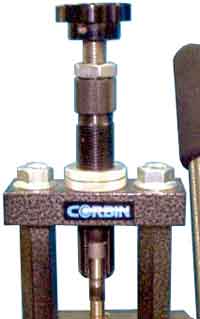|
|
|
Quick-Change Punch Holder, -S type
|
| |

|
Quantity in Basket:
None
Catalog No.: FPH-QC-S
Price: $129.00
Shipping Weight: 1.00 pounds
Sorry, we are no longer taking orders for the Quick-Change Punch Holder, -S type on our legacy website. Please visit our new website at Corbins.com for all future orders. Any question/concerns you can reach us at sales@corbins.com Thank you
|
| |
The Quick Change Punch Holder, type -S, fits the CSP-1 S-press,
the CSP-1H HydroMite, and earlier 7/8-14 threaded head
Corbin swage presses made as far back as the founding of the
company in the 1970's.
The purpose of this accessory is to replace the standard
FPH-1-S punch holder, for the top or external punch, with
one which allows the punch to be slipped in sideways and
quickly slipped out again, between strokes. This provides
room to install longer components than would normally fit
in the space between the punch and die, trading a slight
inconvenience in time per operation for an extended length
beyond what is possible with the standard tooling.
For instance, an extremely long and heavy ultra low drag
(ULD) bullet starts as a core seated into a long jacket,
which might be a little too long to easily fit into the space
between the open die mouth and the external punch. If you
use the FPH-QC-S punch holder, the top punch can slip out
sideways, the seated core and jacket dropped easily into
the die mouth, and then the punch slipped back into the
T-slot again. After forming the bullet, the ogive on
the open end of the cylinder will allow the bullet to
tip sideways at an angle as it is being ejected, so you
probably will not need to remove the punch at that point.
There is a knob on top of the quick-change punch holder,
which sets the amount of clearance for the punch head to
slide in and out of the slot. You want to set the slot
height by turning this knob until the punch fits easily
but is still held well enough not to wobble or fall out,
or to move up and down significantly. The knob lets you
adjust for slight tolerance differences in punch heads,
to give a perfect sliding fit.
Large calibers usually have a top or external punch with
a pre-fitted hex nut, and a removable punch head. Caliber
from about .375 down do not. They are small enough on
the end opposite the head so the standard hex nut on a
normal floating punch holder will fit over the punch easily.
Calibers larger than the hole in the hex punch, or around
3/8-inch, of course won't slip through the hole on either
end unless the head is removable to allow it.
For large calibers, over .375, the hex bushing must be
removed from the punch. If the system is ordered together
and it is clear that the large caliber punch will be used
with a QC punch holder, we will leave off the hex bushing
when assembling the punch. If it is not clear that is
your intended use, we will ship the punch with the hex
bushing installed. You would then need to use a key wrench
to unscrew the cap screw in the punch head, remove the
head, slip the hex bushing off, and then re-install the
head again, to use it with the QC punch holder.
The heads of -S type punches larger than .375 are held
by a Torx T-27 socket cap screw. You will need to use
the T-27 angle key or wrench to fit this screw socket. A
Torx size 27 key is sent with the QC punch holder for
this reason. There is no such screw in the punch holder
itself.
To hold the external punches without damage for removing
the head, use a wood block, a strip of thick copper or
aluminum, or some other firm but pliable material to pad
the jaws of a vise or vise-grip pliers. Grasp the shank
of the punch as close to the hex bushing as possible, to
avoid applying pressure to the end of the punch where it
seals pressure in the die, especially if it has a cavity
machined into the end (nose punch). Holding the punch
at the end is likely to crush the walls around the cavity
and ruin the punch!
Please note that holding the head of the punch while
attempting to remove the head does not work. The screw
threads into the main body of the punch and merely passes
through a hole in the head. You would just spin the punch
body without loosening the screw.
Under no circumstances grasp the punch anywhere with a
pliers or steel vise jaws without sufficient padding to
prevent galling the surface! The punches are hardened but
also very high precision. Mashing them against the high
points on a set of vise jaws can easily exceed the force
needed to damage them beyond repair. Two small pieces of
wood with a hole bored through the junction just under the
punch body diameter is sufficient padding.
|
|
































